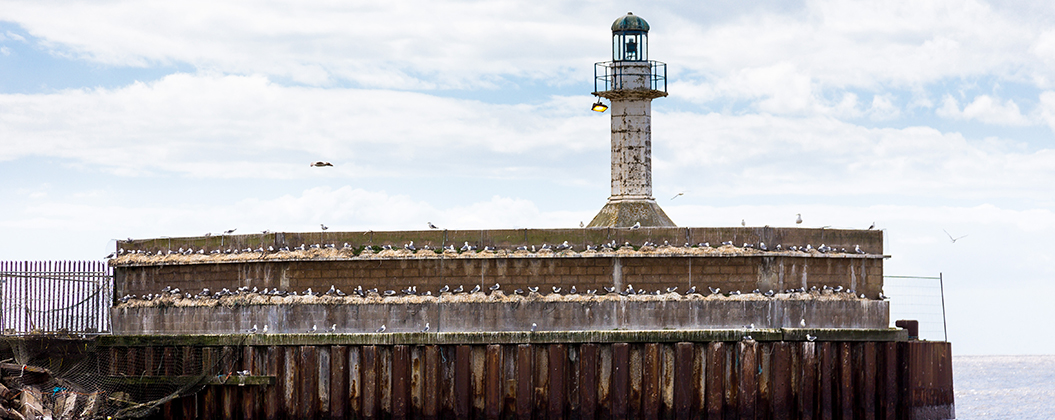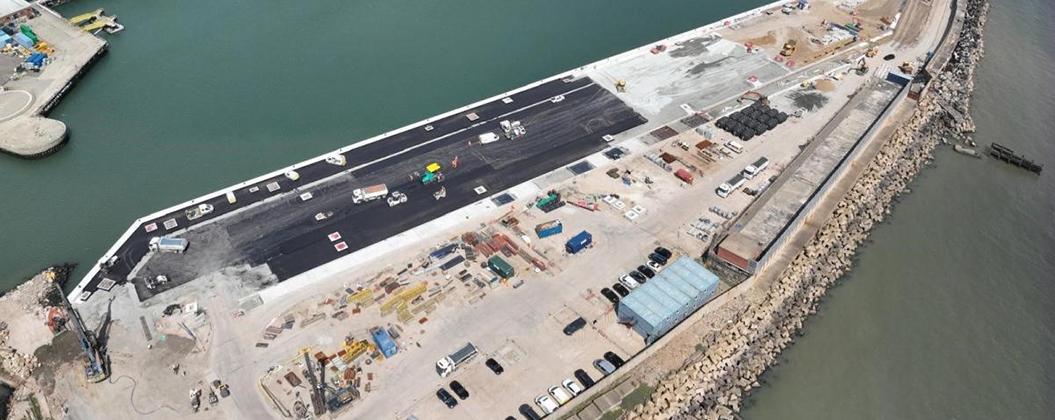In and around March each year in Lowestoft – the UK’s most easterly settlement – the town bears witness to the return of kittiwakes as their breeding season begins. In this post we explore how kittiwakes are also important to ABP, and specifically its operations at ABP’s Port of Lowestoft.

Kittiwakes and their young nesting. Credit: Stephen Waller.
The importance of the Lowestoft kittiwake colony
Kittiwakes are a medium-sized seabirds, which are around 40cm in length, and are easily identifiable by their black-tipped wings and small yellow beaks1.
The global kittiwake population is thought to have declined by 40% since the 1970s2, and they are protected under the Wildlife and Countryside Act 1981, which safeguards the species and their nesting sites. They are classified as “vulnerable” on the IUCN’s red list of threatened species, making it illegal to kill or injure a kittiwake or to disturb an active nest.
Therefore, the Lowestoft colony is of national importance as it is one of the few breeding populations that is not in decline but appears to be stable and even growing3. Furthermore, the Lowestoft breeding population is classed as regionally significant because it is one of only two kittiwake colonies on the Suffolk Coast.
The Port of Lowestoft also plays a vital role in the kittiwake breeding season. Each year the kittiwakes return to structures across the port to nest, such as the tire fenders in Waveney Dock where at times up to one hundred birds can be seen nesting.
1 RSPB - https://www.rspb.org.uk/birds-and-wildlife/kittiwake
2 BBC News - https://www.bbc.co.uk/news/uk-england-suffolk-64873655
3 Swindells, M. (2020). Non-breeding Movements of Black-legged Kittiwakes Rissa Tridactyla from a North Sea Urban Colony. Seabird Journal, 32, pp.33–45. Available at: https://doi.org/10.61350/sbj.32.33

Kittiwakes nesting at the Outer Harbour at the Port of Lowestoft. Credit: Stephen Waller
Given the importance of the population of kittiwakes in Lowestoft, in 2022 the Lowestoft Kittiwake Partnership was established by Suffolk Wildlife Trust, RSBP, East Suffolk Council, Lowestoft Town Council, Lowestoft Vision, ABP and other businesses, community members and local MPs to safeguard nesting birds and reduce any conflict between them and building owners in the town.
As a founding member, ABP played a key part in shaping the vision of the Kittiwake Partnership and the role it plays to conserve and improve public awareness of the Lowestoft’s kittiwake colony. In more recent years, ABP has continued to engage with the Kittiwake Partnership to support their mission. In June 2023, ABP hosted a family friendly event for the Lowestoft Kittiwake Partnership, which provided the opportunity for the community to learn more about kittiwakes and other gull species in Lowestoft, meet the members of the partnership and join a guided walk around the nesting sites of the town. And in July 2024, ABP Lowestoft met with the newly appointed Kittiwake Officer, Amy Duran to discuss how ABP can continue to support the Partnership into the future.
Adaptation to urban life
Kittiwakes are a gentle species that spend their winters foraging at sea, returning to land from March until August to nest. Naturally, they nest on small coastal cliff ledges, which offer protection for their chicks from larger gulls. However, in Lowestoft, kittiwakes have adapted to a more urban and changing environment and can be seen nesting on window ledges, architectural features and other structures that mimic their natural cliffside habitats.
This adaptation is notable because these urban nesting sites often sit along main roads, in busy public areas and close to operational activities in the Port of Lowestoft, however this colony of birds remains unfazed and has a high tolerance to visual and noise impacts.
Despite their high tolerance for human activities, that’s not to say the birds shouldn’t be protected from any potential disturbance, which makes it vital that any works undertaken at the Port of Lowestoft are implemented in a way that is considerate of kittiwake colony.
ABP’s commitment to protecting kittiwakes
Biodiversity is a key theme in ABP’s ‘Ready for Tomorrow’ sustainability strategy, and in line with this ABP is continuously striving to protect the biodiversity around its sites. The protection of kittiwakes has been a key consideration during the consenting and construction work for the Lowestoft Eastern Energy Facility (LEEF), which is currently underway at the Port of Lowestoft’s Outer Harbour.

Lowestoft Eastern Energy Facility (LEEF) under construction at Lowestoft’s Outer Harbour. Credit: McLaughlin & Harvey.
Protecting the kittiwakes from potential disturbances caused by the noise arising from construction has been of high importance during the construction of LEEF. Before any works could start, the works had to be consented with a Marine Licence issued to ABP by the Marine Management Organisation (MMO). This Marine Licence gives specific reference and consideration to the protection of kittiwakes from disturbance. Consequently, we worked closely with ABPmer and renowned ornithologist, Professor Bob Furness, during the consenting phase of the development, who advised on protection requirements. This process helped us to ensure that the appropriate mitigation plan was put in place.
And during the delivery of LEEF, which began in September 2023, Dr Carolyn Barton, a Coastal Ornithologist, visited the site to assess and report any potential signs of disturbance displayed by the kittiwakes in several nesting locations around the Lowestoft Outer Harbour. Dr Barton observed no disturbance to the kittiwakes in the Outer Harbour. The site team will continue to follow guidelines to undertake monitoring, to ensure this trend of no disturbance continues throughout the construction activities, which are scheduled to be completed in October 2024.
Innovative nesting solutions and ongoing conservation efforts
But prior to the conception of LEEF, ABP and other companies based in Lowestoft, have significantly invested in projects to assist with the safeguarding of kittiwakes.
For example, the port houses three ‘kittiwake hotels’ which support the nesting of kittiwakes as part of renewable offshore wind developments for Vattenfall and Scottish Power Renewables. These artificial nesting structures are located behind a concrete wall on the Outer Harbour and have been designed to provide a safe nesting location away from the town and busy port operations for up to 430 breeding pairs of Kittiwakes. Similarly, ABP has worked with Orsted and local stakeholders to facilitate the implementation of offshore artificial nesting structures located around 1km offshore. These structures each have a capacity of allowing around 500 breeding pairs of kittiwakes to nest5.
Ice Factory demolition
As the port continues to transition from a traditional fishing town to a hub for the offshore energy industry, this transformation involves the demolition of the long-derelict Ice Factory on Battery Green Road. The building once hosted the East Anglian Ice Company, where up to 75 tonnes of ice were produced daily is being demolished at part of the wider Port Gateway project led by East Suffolk Council.
Demolition started in May 2024, however the decision was taken to pause the works in June due to birds found nesting on various ledges of the building. ABP has been monitoring the nests regularly to ensure that all birds and their chicks have vacated the site before demolition restarts. This action ensures the birds' safety during this critical period and exemplifies the proactive measures taken to protect this important seabird population.
The return of the kittiwakes to Lowestoft each year is more than just a natural event – it is a testament to the resilience of wildlife in an urban environment. As the town continues to evolve, the ongoing efforts to safeguard these vulnerable birds highlight the importance of balancing development with conservation. Through partnerships, innovative solutions and a deep commitment to biodiversity, ABP in Lowestoft is not only supporting its local economy but also ensuring the sustainable growth of the town as a hub for supporting the offshore energy industry while protecting the wider environment.
4. Vattenfall - https://group.vattenfall.com/uk/newsroom/pressreleases/2023/kittiwake-hotel-in-lowestoft
5. Orsted - https://orsted.co.uk/insights/from-the-front-line-of-climate-action/innovative-artificial-bird-nests-support-vulnerable-birds-and-green-energy#:~:text=An%20innovative%20structure&text=Each%20artificial%20nesting%20structure%20comprises,designed%20to%20mitigate%20avian%20predators.




